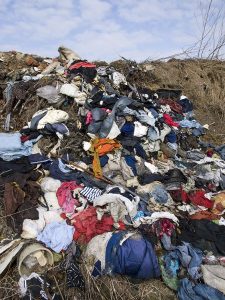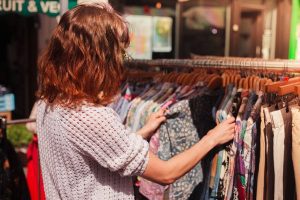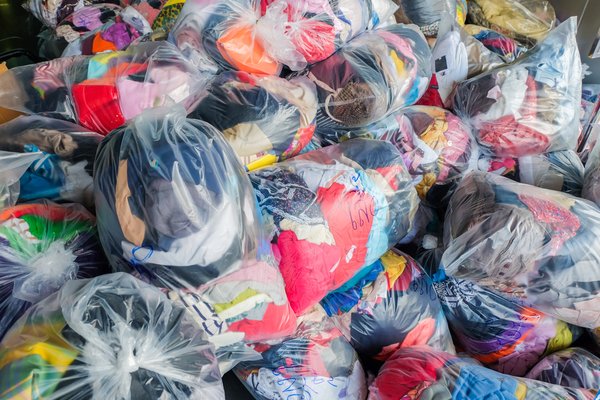What happens when nearly half of all North Americans – that is, approximately 46 percent – claim that they have “way too much stuff” in their closets? Many studies show that a great number of consumers are actively finding solutions to address the over-accumulation of materials in their closets. Millenials in particular appear to be deeply invested in tracking down viable options that help them still meet their fashion needs while also addressing the negative implications and outcomes of a disposable fast fashion global marketplace. This is particularly evident in the practice of thrifting which is how millennials successfully incorporate this fashion forward and economically ethical practice. We know that the more consumers consider the environment as they purchase their fashion goods, the more they reduce the overflow of landfills, and save a substantial amount of their disposable income.
There is no doubt that as the “crisis of stuff” deepens, consumers are increasingly becoming interested in achieving environmental sustainability. Ecosalon has reported that, “clothing has an enormous, toxic, environmental footprint, one that gets bigger when it is unnecessarily wasted and not given the opportunity to live up to its fullest capacity through multiple lives, multiple owners or textile recycling.” And as buyers learn more about the ways that the modern clothing market is revolutionizing, they are learning that clothing is 100% recyclable and instead of discarding it in a landfill once they are done with an item, they can move it into a new market – the mixed rags market. By doing so, they are re-making old items into new items and re-direct items away from ever-growing landfills.
By moving items into the mixed rags market, consumers are contributing towards transforming mountains of secondhand clothes into vintage diamonds that match the trends of the current fashion era. Those in the market then scale what consumers have discarded to find items that will catch the eye of a new consumer – one that is looking for a particular colour, size, fit, quality, and label. Experts indicate that this current fashion era and consuming public is searching for mixed rags items have four major uses. First, nearly 45% of materials labelled “mixed rags” are sold as secondhand clothing to other domestic or overseas markets. This of course is one of the key markets that is transforming the mixed rag market and addressing the “crisis of stuff” in a heads-on way. But there are other key ways that mixed rags are mobilized and consumed. They include: wiping rags for the automotive, home improvement and manufacturing industries; shredding materials (as in the case of fibres that are used for materials such as couches and chairs, carpet padding, home insulation, blankets, tablet and phone cases); and finally, a remaining 5% that are often disposed of because they are listed as compromised (typically due to chemical contamination or water damage) and therefore unusable.
To create this new approach to the fashion market, those in the mixed rag market are looking for clothing that is considered “used,” and that was either not sold in a resale, or was not suitable for resale. These items typically consist of store returns, apparels and household rummages from thrift store locations or discount apparel stores. Experts dictate that mixed rag items are labelled as such because they are imperfect — meaning, they may have stains, rips, broken zippers or missing buttons. They may also usually have pricing tags from their original thrift store attached. Before arriving in the hands of their new owners, mixed rag items typically are first donated to a thrift store or charity, and if they are not sold, they are then removed from the storefront and sent to a warehouse. Mixed rag market experts then sort the items, compress them into bales, and store them until they can be sold. By using this clothing market strategy, entrepreneurs and consumers can work together to save approximately four billion pounds of used clothing from being trashed into landfills a year.
In the current mixed rags market, Bank & Vogue is noted as a competitive and reliable seller of mixed rags materials. On the one hand, we make it our priority to finding innovative and relevant solutions for the crisis of stuff, and the environmental challenges posed by textile waste. Much of our clientele credit us for being able to source quality products and provide customers desirable mixed rags items, with loads of loose rather than baled mixed rags (which are generally a part of special orders to our sellers). Our product experts then examine each box for quality control prior to proceeding to the pricing stage of marketing mixed rag items. In order to meet the demands of the modern state of the mixed rag market, we typically buy in bulk from a variety of clients who include: clothing graders, personal collectors, store liquidations, estate sales and deadstock items. By paying close attention to the items, the market and the demands of mixed rag market

consumers, not only do we help get valuable old items into new hands, but we also are helping shift the retail success of our company and the mixed rag market as a whole. In order for this strategy to work successfully, we take our job seriously to find the materials our consumers need, and we use processes that ensure that each load meets our clientele’s expectations.
In order to achieve this level of sustainability in the textile industry, entrepreneurs invest in high institutional grade of used clothing which is generally produced by second-hand and thrift stores (whether it be large and small thrift store retailers, not-for-profit community based collectors, or private collectors and consolidators). They then generate a way to move it across states and provinces in the United States and Canada. To learn more about our processes and our general approach to logistics, please contact our team at 1-866-613-0719 (North America) or 1-613-747-8465 (International).








